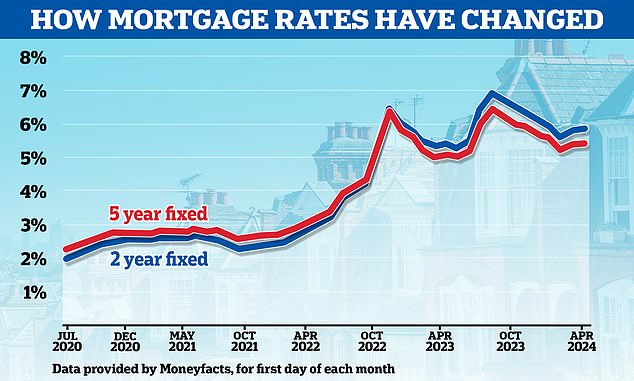Houses for sale at their highest level in five years, says Zoopla: Will house prices fall?
According to Zoopla, the number of homes for sale is at a five-year high, raising questions about whether house prices can fall further.
The housing portal showed that there are 20 percent more homes on the market than this time a year ago.
Zoopla said the supply represented a ‘huge increase’ and that the 2022 supply was double what was available at the same time.
However, as more homes come onto the market, mortgage rates are rising again, meaning some buyers may be forced to postpone their plans.
Some experts suggest this will result in the supply of housing exceeding demand and could lead to prices falling in some areas.
Listing supply: supply is highest in the Southwest, where real estate agents have 2.5 times as many homes for sale compared to spring 2022
Jonathan Hopper, chief executive of buyers’ agents Garrington Property Finders, said: ‘Falling interest rates are no longer helping buyers, but the jump in the number of homes for sale is.
“Buyers now have a much wider range of stocks to choose from than they did just a few months ago.
‘The delicate balance between supply and demand is the biggest factor influencing house prices, and in many areas this mismatch is large – and growing.
‘Many real estate agents now report that the number of homes coming onto the market is four or even five times as high as the number of prospective buyers who come forward.’
Izabella Lubowicka, senior property researcher at Zoopla, added: ‘The current spring boost in supply on the market is giving potential buyers more choice than ever, but affordability continues to impact budgets.
‘Sellers putting their homes on the market should take this into account and ensure they price their property realistically to achieve a sale.’
Higher mortgage rates dampen demand
At the beginning of the year, a reduction in mortgage rates seemed the only way out. However, since the beginning of February, mortgage rates have been rising again.
Financial markets have backtracked on earlier predictions about rate cuts, with a ‘higher for longer’ scenario now looking more likely.
At the start of this year, markets were predicting as many as six or seven base rate cuts in 2024. This has now fallen to just two or three.
Mortgage lenders have responded by raising prices. Today, Barclays, HSBC, NatWest, Accord and Leeds Building Society have all increased mortgage rates.

Peter Stimson of MPowered Mortgages thinks the high supply is likely to keep prices down until interest rates start to fall again
Peter Stimson, head of product at mortgage provider MPowered, thinks current mortgage rates could drive house prices down.
“The January house price rise now seems as forgotten as most people’s New Year’s resolutions,” says Stimpson.
‘The wave of mortgage rate cuts at the start of the year boosted both supply and demand as the property market emerged from the slumber of 2023.
‘But the interest rate cuts haven’t just stopped; in many cases they have gone in the opposite direction. As a result, mortgage costs remain high and demand for housing cools.
‘With thousands more homes coming onto the market, buyers can be more choosy – especially in areas where supply exceeds demand.
“As a result, we are increasingly seeing a Mexican standoff between buyers and sellers. Realistically priced properties sell quickly, but less desirable and optimistically priced properties linger.
‘While the increase in supply is welcome – it is fundamental to a free-flowing market – it is likely to keep prices low until interest rates start to fall again.’
Which areas have the most homes for sale?
Supply is highest in the South West, where agents have 2.5 times as many homes for sale than in spring 2022, according to Zoopla.
In Cornwall, the number of available homes has also increased by 159 per cent compared to spring 2022.
In North Kesteven, Lincolnshire, the number of homes available has increased by 155 percent, while in Bournemouth, Christchurch and Poole there are 146 percent more homes on the market.
It’s not surprising that homes take longer to sell in these locations than in other parts of the country.
For example, in Cornwall it takes an average of 20 days longer to sell a property compared to spring 2022, and 23 days longer in Bournemouth, Christchurch and Poole – compared to a national average of 16 days.

Back on the rise: mortgage rates have been rising since early February
Sam Turner, director of Cornwall estate agent Kivells, said: ‘There has been a big increase in the number of new properties coming onto the market, giving buyers more choice.
‘This also supports the moving process for our suppliers, as they have more choice when making further purchases.’
Wales and the East Midlands are also seeing an increase in the number of homes coming up for sale, according to Zoopla.
In these locations, more than 60 percent of the stocks currently on the market are more expensive than the regional average, indicating a potential mismatch between what buyers can afford and what is available for purchase.
In the East Midlands, the increase in supply has been most pronounced in more rural areas such as southern Lincolnshire and Derbyshire, including the Peak District. These areas are also priced above the regional average.
This indicates that the inventory of homes for sale in higher-end markets is moving more slowly, as affordability remains a greater challenge for potential buyers in areas where larger budgets are required.
Increase in larger homes coming onto the market
According to Zoopla, the average estate agent outside London now has twice as many properties with four bedrooms or more available than in February 2022.
The supply of three-bedroom homes has also improved, with 25 percent more homes available compared to this time last year.
“At the top end of the market, two ‘d’s’ often underlie the increase in sellers: debt and downsizing,” says buying agent Jonathan Hopper.

Jonathan Hopper, chief executive of buying agency Garrington Property Finders, says the balance between supply and demand is the biggest factor influencing house prices and the gap is widening.
‘Every month, thousands of owners with a large mortgage see their monthly repayments increase by hundreds or even thousands of euros when they take out a new mortgage.
“For some, the increase in costs is too much to bear and they have to move to a smaller area just to keep their monthly expenses the same.
‘We are also seeing a steady increase in the number of baby boomers moving to smaller properties, partly to reduce their expenses, but also to free up savings for retirement.
‘Millions of Brits treat their property as their retirement, and some are starting to cash in on those years of built-up equity.
‘Meanwhile, high borrowing costs mean some buyers are still struggling to get the home they want, but better availability should keep the property market ticking over and putting pressure on prices as we wait for interest rates to rise will drop again in the second half. half the year.’
He adds: ‘For buyers, that extra choice brings power. With supply exceeding demand in some areas, price increases have stalled and affordable buyers, who have their finances in place, may find themselves in a very strong bargaining position.
‘As a result, sellers may need to rein in their price ambitions, especially those trying to sell larger homes outside London, where supply is particularly strong.
Can house prices still rise from here?
It appears that house prices will fall rather than rise in the coming months.
However, there are those who will argue that the increase in housing supply means that house prices will stagnate rather than fall.
‘It is important to keep the increase in the number of homes for sale in perspective.’ says Andrew Wishart, senior economist at Capital Economics.
‘The Rics survey among surveyors shows that the number of homes for sale is still very low from a historical perspective.
“And with unemployment still very low, the biggest increases in mortgage costs behind us, and lenders offering generous options to borrowers struggling to meet their repayments, I don’t expect to see a wave of homeowners being forced to foreclose on their homes. to sell.
‘Instead, we think rate cuts starting later this year will revive the housing market in 2025, boosting demand and driving house prices up by 5 percent.’
Simon Gerrard, managing director at Martyn Gerrard Estate Agents, said they are seeing the opposite in their offices rather than supply exceeding demand.
‘These figures may show an increase in supply in the housing markets outside London and the other major cities in Britain, but we are certainly not seeing a large or sustained increase in the supply of available homes in urban areas.
‘There may be a small seasonal increase in the number of homes on the market, which we would expect given the spring.
‘Overall, however, the market remains trapped in a vicious cycle of high demand, low supply and the hope of owning their own home remains out of reach for many.’
Some links in this article may be affiliate links. If you click on it, we may earn a small commission. That helps us fund This Is Money and keep it free to use. We do not write articles to promote products. We do not allow a commercial relationship to compromise our editorial independence.
